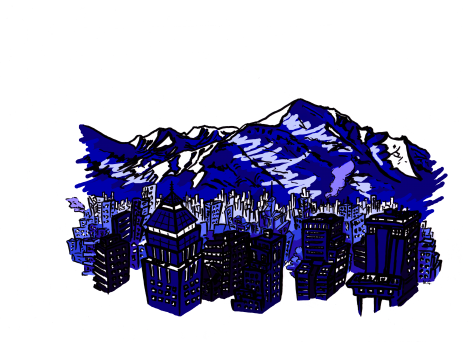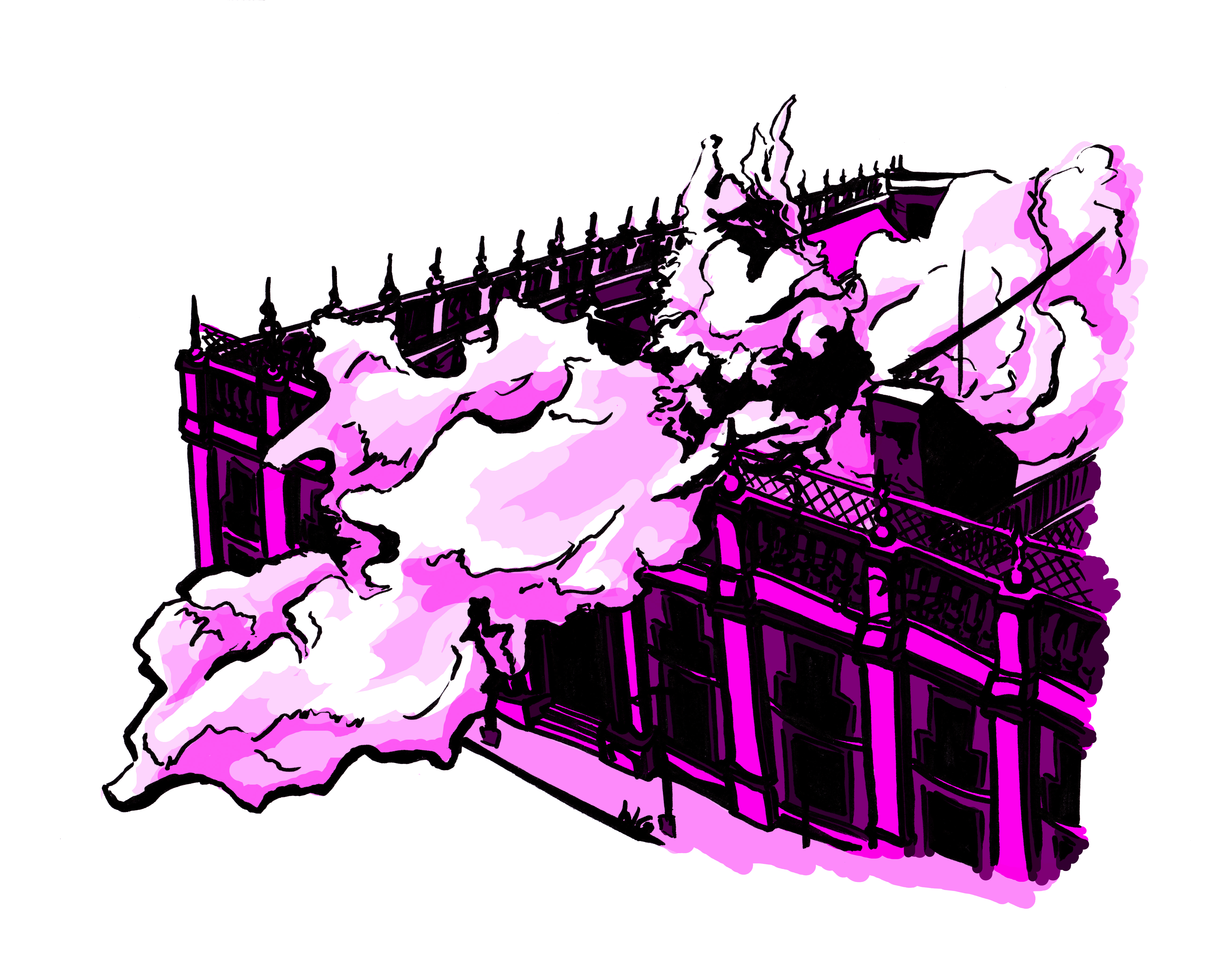A tear gas fog
police officers armed to the teeth
a woman digs through the trash
cars go by every which way
and the awful asthma trees
the city is doomed to disappear
it’s the world, they tell me
don’t worry
it’s the year 1979
—Nicanor Parra, “1979”
I. Santiago & Arrivals
No one should be surprised if the writer feels an unbearable isolation, similar to illness, as he takes his first steps into that new space. If we imagine the arrival: stepping off the plane, smog-obscured mountains encircling him, 70 or so taxi drivers each struggling, swearing and singing in Spanish to get a foreigner into their car. It’s wonderful, entering to such a reception. Everything seems to begin just as it should. But a problem presents itself: as a dream and this new reality clash, the audience realizes that nothing is as it was expected to be. And with the glimpse of the first water-cannon-equipped police truck, Santiago begins.
II. Santiago & Fear
To write about fear is a very strange thing, akin to purposefully revisiting a place that you would prefer to forget, to wandering through the alleys of time. It is to translate memory, and link the events of that specific past with those of the present. But I shouldn’t digress too far from the story. It starts with a copy of Antipoemas, by the renowned Chilean poet Nicanor Parra, tucked into my jacket pocket as I step out the gate of my rundown, two-storey building, a 15-minute walk from the Plaza de Armas and the center of Santiago de Chile.

As I walked on that first night, past dogs barking in the alleys, I retreated into my thoughts, realizing what it means to be lost, with no plans, no commitments and no one. So I went towards the city center and looked around me, at the buildings I knew from books and poems that were being transformed from ideas into places. Spaces are always a combination of the two — how much of either depends on the person walking through them. As my roommate said that first day, “People here make so much money, so why don’t they do anything about the street dogs?” She worked in an upper-class part of Santiago, teaching English to business people. I responded to her in my mind, saying that half the Chilean work force earns the minimum wage, equivalent to 386 American dollars a month. Numerous surveys rank Chile as one of the most economically unequal societies in the world.
~
But it’s true, some people do make a lot of money. Las Condes, La Reina, Los Dominicos. These neighbourhoods radiate wealth, with European-style villa homes, and Parisian street lamps lining the wide, empty streets. These places make up one Santiago. They have clean air, nice cars, sprawling malls and private security. They are the “triumph” of the “Miracle of Chile,” as Milton Friedman called it, the period of praised free market reorientation in the 1970s and 1980s, which led to large economic growth — for the upper classes at least. Chile’s economy actually grew just one per cent total between 1973 and 1989. But I knew all that before I arrived. So as I walked, on that first night, past posters that declared “Nationalize the Lithium!” and “Profit out of Education!” the streets served as both reminders of and introductions to the vast polarization of Chile, to the conflicted feelings that each building, each statue and each flag conjure up amongst the different Santiagos, forced together in that space between the mountains.
III. Santiago & the Past
The year is 1970. Salvador Allende, a Marxist and head of the Chilean leftist coalition Popular Unity, comes to power in an election in which he wins 36.63 per cent of the vote. He is then, due to the lack of an absolute majority, confirmed president by a vote in the Chilean Congress. The CIA spends $425,000 on an anti-Allende campaign during the election, while the KGB spends $400,000 on behalf of Popular Unity. Allende becomes the first democratically-elected Marxist president in Latin America .
I walk through Plaza Italia, where the Mapocho river used to fork before it was diverted. I see all of the apartments, dark now because it’s very late, towering over the symphony hall and the 24-hour cigarette stands. Julio, from Chilean-writer Alejandro Zambra’s Bonsai, lives in one of these apartments, I think to myself. A police truck sits in the square. As Zambra said, “I grew up in a dictatorship, I said my first words in a dictatorship, I read my first books in a dictatorship.” The memories of an entire generation linger, curled up beside the dogs licking crumbs off the sidewalk.
~
The year is 1973. In the March parliamentary elections, Allende’s coalition increases it’s share of the vote to 44.11 per cent, but is faced by a majority right-wing opposition with CIA support. On September 11, a military coup takes place, led by General Augusto Pinochet. The military declares control of the country, but Allende refuses to resign, and broadcasts a final message on national radio. When the military breaks into the presidential palace, Allende is found dead, having committed suicide. Over the next 17 years, more than 40,000 people will be kidnapped and tortured, killed or “disappeared” by the dictatorship.
~
“The first country in the world to make that momentous break with the past — away from socialism and extreme state capitalism toward more market-oriented structures and policies — was not Deng Xiaoping’s China or Margaret Thatcher’s Britain in the late 1970s, Ronald Reagan’s United States in 1981, or any other country in Latin America or elsewhere. It was Pinochet’s Chile in 1975,” Stanford’s Hoover Institute gushed in a 2007 report, praising Pinochet and his advisers. The argument is based in the idea that the market is pure, that economic freedom is the most important kind of freedom — more important than democracy.
~
The year is 1982. Chile has just fallen into the worst banking crisis in its history. The Pinochet government intervenes in the banking system, after implementing radical free market policies for the previous nine years, and ends up controlling more of the economy than the democratic government that had preceded it. From 1975 to 1982 the Chilean foreign debt rose from the equivalent of $5.3 billion to $17 billion, caused by the excess borrowing of private companies unable to pay their loans. The military government backed their debts, despite mass poverty.
~
The year is 2012 and it is night as I walk towards the Plaza de Armas and the presidential palace, with this history hanging on the walls around me. Statues still stand in honour of members of the regime, while its far-right economic ideology (despite both breeding and being bred out of inequality) has been idealized and adopted by much of the world. So with every student rally that struggles to change the massively privatized education system, and every Pinochet memorial that draws neo-Nazis out of the cracks, this history is made new again, and new violence clogs the streets.
IV. Santiago & Dionysus

Another night I was walking alone at around 2 am in Barrio Yungay, one of the oldest neighbourhoods in Santiago, and I was afraid. After buying a beer from a guy in an alley (beer is cheaper than bread, after all), I saw some graffiti that read as follows:
“Interviewer: What bores you?
B: Empty discourse from the left. I expect it from the right.”
I went back the next day to try and find it. Worn grey brick stared back at me like a mirror that reflected frozen sand. Those late night phrases had either left before I could find them again or hadn’t arrived yet.
~
The year is 1990. The percentage of the population living below the poverty line is about 40 per cent, down from 50 per cent in 1983 and 45 per cent in 1987. After a referendum on his leadership in 1988, Pinochet steps down and a new democratic government is sworn in. Pinochet hands over power, after passing a law guaranteeing amnesty for most of the military, having reached an agreement to remain Commander-in-Chief of the armed forces (as well as “Senator for Life”), and attempted to preserve his economic model by making it more difficult to change the constitution. Patricio Aylwin, a Christian Democrat who opposed Allende, becomes the new president of the Republic. After the return to democracy, there will be three Truth and Reconciliation Commission reports released in an attempt to come to terms with the abuses of the military dictatorship.
V. Santiago & the Present
It’s now August, 2012. Universities have just returned from winter break. The student protests resume today, with the biggest demonstrations planned in months. I walk along La Alameda, the biggest street in Santiago, with a friend and enter the protest area. The towering buildings and landscaped boulevards reflect the new wealth of Santiago: a wealth that presents itself in the architecture, in the billboards and in the private universities, but which remains out of reach for the majority. In this society, to get a university degree, poor students find themselves with debts equal to the cost of an apartment, while the elite need not share their higher-than-first-world standard of living. This disparity will continue, under the political class of either the mainstream left or right. But the militarized police break up my thoughts, as armoured trucks (purchased from Apartheid-era South Africa), firing water cannons and shooting tear gas, drive towards us. We run back and forth to try not to get hit. The tear gas burns, though most students have old, faded gas masks. Eventually police come in on foot, with riot shields. My friend and I hide in a hot dog shop and leave through the back door, which leads to an alley.
~
Under the Pinochet regime, large foreign companies were those who profited most from the new economic “freedom.” By exploiting labour through banning unions, privatizing all levels of education, and cutting corporate taxes, Pinochet allowed the means of the upper classes in Chile to grow while, at the expense of the majority, foreign businesses took the country’s natural resource-based wealth back to their shareholders. The democratic governments that have followed have done little to change this, and even ostensibly center-left governments have generally adopted the capitalist programs of the Pinochet years. Pinochet’s 1980 constitution is still in place, though small parts of it were finally amended in 2005.
~
One of the groups that has profited the most from these business-favouring conditions has been the Canadian mining giant, Barrick Gold. Driving through the Atacama Desert, a different night, I see spray painted slogans on rocks beside the highway, proclaiming “Barrick Out” next to small shrines to Jesus. Nostalgia for the Light, a documentary by Patricio Guzman, explores these same deserts, showing the astronomy community, with its telescopes exploring the stars and the past, contrasted with groups of mothers, still searching for their sons’ bodies amongst the rocks where Pinochet hid many of his victims. The copper mines are here as well, constant reminders that while change may have come, it has not been nearly enough.
The Pascua Lama project (a Barrick mine that produces gold, silver and copper) is just one example of the controversies found in Chile, that follow Barrick Gold wherever it goes. The mine is in the Andes, occupying traditional indigenous land. The government did not consult the inhabitants at the project’s beginning and has been known to use the “special forces” to clear protesters from mining sites or pipeline routes. Pascua Lama has been particularly divisive, as activists and scientists claim it is extremely harmful to the environment, In 2010, the Atacama Environmental Authorities began the process of punishing Barrick Gold for illegally damaging the glaciers and rivers and for breaching the health standards of the local Environmental Qualification Resolution. As Sergio Campusano Vilches, president of an indigenous ecological group explains, “Our Community was intentionally ignored by the State of Chile during the approval process for the Pascua Lama project because we oppose mega-mining development within our lands. This has to be recognized and amended. We sincerely hope we can find the justice that was denied to us in our own country.” He highlights the largest problem with the compromise to reach democracy: it came at too high a price, allowing large corporations to maintain influence and power. The Truth and Reconciliation Committees have not sufficiently dealt with the most destructive legacy of the dictatorship; its economics, which continue today.
VI. Santiago & Apollo
In a 2010 interview with The Globe & Mail, Peter Munk, founder and chairman of Barrick Gold, stated, “It is your obligation to give back as much as you have taken from a country… I’ve made some money and I wish to give it back.” As the Globe says, there are “two prongs of Mr. Munk’s philanthropic vision: stay focused and support Canada’s role on the world stage.” The interview was conducted in the wake of his $35 million donation to the University of Toronto’s Munk School of Global Affairs. The university has been criticized at length for the lack of transparency in its agreement with Munk, and Munk himself has been accused of exercising outsize influence. Barrick Gold has been under investigation in numerous countries for human rights abuses, environmental destruction and involvement in corruption. But the University of Toronto knows all this. In fact, they profit from it, owning $1,206,000 worth of Barrick Gold stock as of March 31, 2012. It’s just one part of their investment plan, which includes companies such as Imperial Oil, El Dorado Gold and Enbridge.
U of T claims that it cares about inclusivity. It presents itself as an environmentally, socially conscious institution, which offers education not just for the few that can afford it. But it does these things while actively supporting and being supported by companies, like Barrick, that take advantage of people around the world. While Chile continues to have some of the highest post-secondary fees in relation to the average income, the University of Toronto accepts Barrick’s and Peter Munk’s money — earned in an economic system which excludes the majority of the Chilean population — contradicting many of the university’s professed values.
~
So while Peter Munk buys himself a legacy, the problems of all the different Santiagos still exist. To the south the houses appear entirely different; these are the traditional neighbourhoods of the poor, places where Pinochet did absolutely nothing to encourage development. The walls and roofs are cracking, while a 20-minute subway ride away sit mansions, protected by the police and security forces, who seem to have a greater presence in these neighbourhoods. Peter Munk has taken much from Chile, but he is not concerned with giving back — at least not to Chileans anyway. Of all of Canada’s qualities, economic freedom is clearly at the top of his list to “spread,” as illustrated by a statement he made in 1996, where he praised Pinochet for “transforming Chile from a wealth-destroying socialist state to a capital-friendly model that is being copied around the world.” Munk is quoted as saying about Pinochet’s human-rights abuses on anti-Munk website munkoutofuoft: “They can put people in jail, I have no comment on that, I think that may be true…I think [the end justifies the means] because it brought wealth to an enormous number of people. If you ask somebody who is in jail, he’ll say no. But that’s the wonderful thing about our world; we can have the freedom to disagree.”
Today, those who disagree are greeted with tear gas and water cannons. Under Pinochet, they were welcomed with worse.
VII. Santiago & A Dream of Franz Kafka
“it all came down to nothing
& of nothing, there is very little left”
—Nicanor Parra, “A Resounding Zero”
~
On my last night I wonder, where does all of this leave us? While the student movement may be flawed, it is at least understandably so. As the only group that presents any hope for a different future, it is filled with competing thoughts, ideologies and factions. It is born out of a lack of other options. When politicians and universities alike can be paid and influenced by the likes of Barrick Gold, when elected leaders change little or nothing, the only democracy that exists is found in the street, the sole place where people can declare that it is not okay for us to continue on this path, for one society to slide forward while exploiting another, for one education to be financed while another’s is not.
And so I walk and think of Franz Kafka because he saw modernity for what it was, long ago. I meet him in an alley and he nods his head to me, before walking off in the rain. I go the other direction.


